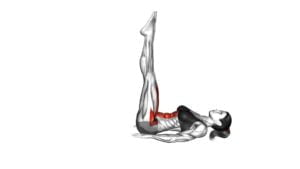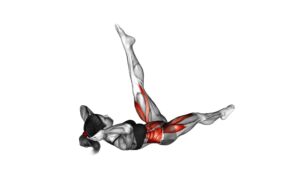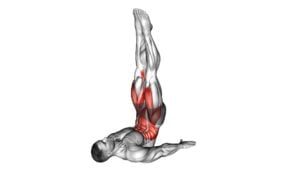Lying Single Leg Raise (male) – Video Exercise Guide & Tips

Are you looking to strengthen your lower body and improve your balance?
Watch This Exercise Video
Then the Lying Single Leg Raise is just the exercise for you.
In this video exercise guide, we'll show you the proper form and technique, along with modifications and progressions to challenge yourself as you get stronger.
Plus, we'll share common mistakes to avoid and offer tips for maximizing the effectiveness of this exercise.
Get ready to take your leg workout to the next level!
Key Takeaways
- The lying single leg raise strengthens leg muscles such as quadriceps, hamstrings, and calves.
- It improves overall leg strength for walking, running, and sports.
- This exercise enhances balance and stability.
- It works abdominal muscles for improved core strength.
Benefits of the Lying Single Leg Raise
You will benefit from the lying single leg raise by strengthening your leg muscles. This exercise is great for targeting the muscles in your legs, including your quadriceps, hamstrings, and calves. By regularly performing this exercise, you can improve your overall leg strength, which can be beneficial for various activities such as walking, running, or playing sports.
Additionally, the lying single leg raise can also help improve your balance. By challenging your stability and forcing you to engage your core muscles, this exercise can enhance your ability to maintain a steady stance and prevent falls or injuries.
Speaking of core muscles, the lying single leg raise also works your abdominal muscles, contributing to improved core strength. Having a strong core is essential for maintaining proper posture, preventing lower back pain, and enhancing overall body stability.
To maximize the benefits of the lying single leg raise, it's important to ensure proper form and technique. So, let's now dive into the next section to learn more about how to perform this exercise correctly.
Proper Form and Technique
To ensure proper form and technique for the lying single leg raise exercise, it's important to consistently practice and focus on maintaining balance and stability. One of the most common errors people make is lifting their leg too high, which can strain the lower back and hip flexors. Remember, the goal is to lift your leg while keeping your lower back flat on the ground.
Another common misconception is that you need to rush through the exercise. Take your time and focus on controlled movements to engage the muscles properly.
To perform the lying single leg raise correctly, lie flat on your back with your legs extended. Engage your core and press your lower back into the ground. Slowly lift one leg off the ground, keeping it straight and maintaining control throughout the movement. Only lift your leg as high as you can while still keeping your lower back flat. Pause briefly at the top, then lower your leg back down with control. Repeat on the other side.
By practicing proper form and technique, you'll maximize the effectiveness of the lying single leg raise exercise and reduce the risk of injury.
Now, let's explore some modifications and progressions to challenge yourself even further.
Modifications and Progressions
To challenge yourself even further in the lying single leg raise exercise, you can incorporate modifications and progressions.
These variations will help you increase the difficulty and intensity of the exercise, allowing for continued growth and improvement in your lower body strength and stability.
One modification you can try is adding ankle weights. By strapping on a pair of ankle weights, you're increasing the resistance and making your muscles work harder during the exercise. This can help to further strengthen your hip flexors and quadriceps.
Another modification is to perform the exercise on an unstable surface, such as a stability ball or a balance board. This forces your muscles to work even harder to maintain balance and stability throughout the movement. By challenging your stability, you're also engaging your core muscles more effectively.
As you progress in your strength and stability, you can also try performing the exercise with both legs raised simultaneously. This further increases the difficulty as you're now lifting more weight and requiring more strength and control from your muscles.
Incorporating these modifications and progressions into your lying single leg raise exercise routine will help you continue to challenge your muscles and improve your overall lower body strength and stability.
Remember to always listen to your body and adjust the difficulty as necessary to avoid injury.
Common Mistakes to Avoid
To ensure proper form and maximize the effectiveness of the lying single leg raise exercise, it's important to be aware of common mistakes that should be avoided. By understanding these mistakes, you can ensure that you're performing the exercise correctly and getting the most out of your workout.
One common mistake to avoid is lifting your leg too high. While it may seem tempting to lift your leg as high as possible, doing so can put unnecessary strain on your lower back and hip flexors. Instead, focus on lifting your leg to a comfortable height while keeping your core engaged and your lower back pressed into the floor.
Another mistake to watch out for is allowing your lower back to arch. This can happen if you lack core strength or if you're not engaging your abdominal muscles properly. To avoid this, make sure to actively engage your core throughout the exercise and focus on keeping your lower back flat against the floor.
Lastly, be mindful of your breathing during the exercise. It's common to hold your breath or breathe shallowly when performing challenging movements, but this can hinder your performance and limit the benefits of the exercise. Remember to breathe deeply and evenly throughout the movement, inhaling as you lower your leg and exhaling as you raise it.
Tips for Getting the Most Out of the Exercise
Maximize your results by engaging your core and maintaining proper form throughout the lying single leg raise exercise. This exercise not only targets your lower abdominal muscles but also helps in improving balance and increasing flexibility.
To get the most out of this exercise, follow these tips:
- Engage your core: Before starting the exercise, activate your core muscles by drawing your belly button towards your spine. This will help stabilize your pelvis and protect your lower back.
- Maintain proper form: Lie flat on your back with your legs extended. Keep your arms by your sides and your palms facing down. As you raise one leg, make sure to keep it straight and avoid bending at the knee. Slowly lower your leg back down without touching the ground, and repeat on the other side.
- Focus on balance: As you raise and lower your leg, focus on maintaining your balance. Imagine a straight line from your head to your toes and try to keep your body aligned throughout the movement.
- Increase flexibility: To improve flexibility, gradually increase the range of motion as you become more comfortable with the exercise. You can also incorporate dynamic stretches before and after the exercise to further enhance your flexibility.
Frequently Asked Questions
How Many Repetitions of the Lying Single Leg Raise Should I Do?
To determine the optimal frequency of lying single leg raise repetitions, it's important to consider your fitness level and goals. Start with 10 to 15 repetitions per leg and gradually increase over time.
If you're looking for variations and modifications, you can try adding ankle weights or using a resistance band for added resistance. Remember to listen to your body and adjust as needed.
Consistency is key for progress and avoiding injury.
Can I Perform the Lying Single Leg Raise if I Have a Knee Injury?
If you have a knee injury, it's important to consult with a healthcare professional before performing the lying single leg raise or any other exercise. They can provide guidance on rehabilitation options and alternative exercises that are safe for your specific condition.
It's crucial to prioritize your recovery and avoid further aggravating your injury. Listen to your body and follow the recommendations of your healthcare provider to ensure a successful rehabilitation process.
Is It Necessary to Use a Yoga Mat or Any Specific Equipment for This Exercise?
No, it isn't necessary to use a yoga mat or any specific equipment for the lying single leg raise exercise. However, using a yoga mat can provide some benefits, such as added comfort and stability.
If you're a beginner, you can modify the exercise by keeping your knee slightly bent or by placing a rolled-up towel under your lower back for support.
Remember to start slowly and listen to your body's limits.
Can I Perform the Lying Single Leg Raise if I Have Lower Back Pain?
If you have lower back pain, it's important to consult with a healthcare professional before attempting the lying single leg raise. They can provide guidance on whether it's safe for you to perform this exercise.
The lying single leg raise can be a beneficial exercise for strengthening your core and improving hip stability.
However, there are variations that may be more suitable for individuals with lower back pain, such as the bent knee single leg raise or the standing single leg raise.
How Long Should I Hold the Raised Leg Position During the Exercise?
During the lying single leg raise exercise, you should hold the raised leg position for about 2-3 seconds before lowering it back down. This helps to engage your core and strengthen your hip flexors.
Remember to maintain proper breathing technique throughout the exercise, exhaling as you lift your leg and inhaling as you lower it.
Avoid common mistakes like lifting your leg too high or arching your lower back.
Conclusion
In conclusion, the lying single leg raise is a beneficial exercise that targets the core and hip muscles. By maintaining proper form and technique, you can maximize the effectiveness of this exercise.
Remember to avoid common mistakes and consider modifications and progressions to challenge yourself.
By following these tips, you can get the most out of this exercise and improve your overall strength and stability.

Author
Years ago, the spark of my life’s passion ignited in my mind the moment I stepped into the local gym for the first time. The inaugural bead of perspiration, the initial endeavor, the very first surge of endorphins, and a sense of pride that washed over me post-workout marked the beginning of my deep-seated interest in strength sports, fitness, and sports nutrition. This very curiosity blossomed rapidly into a profound fascination, propelling me to earn a Master’s degree in Physical Education from the Academy of Physical Education in Krakow, followed by a Sports Manager diploma from the Jagiellonian University. My journey of growth led me to gain more specialized qualifications, such as being a certified personal trainer with a focus on sports dietetics, a lifeguard, and an instructor for wellness and corrective gymnastics. Theoretical knowledge paired seamlessly with practical experience, reinforcing my belief that the transformation of individuals under my guidance was also a reflection of my personal growth. This belief holds true even today. Each day, I strive to push the boundaries and explore new realms. These realms gently elevate me to greater heights. The unique combination of passion for my field and the continuous quest for growth fuels my drive to break new ground.







